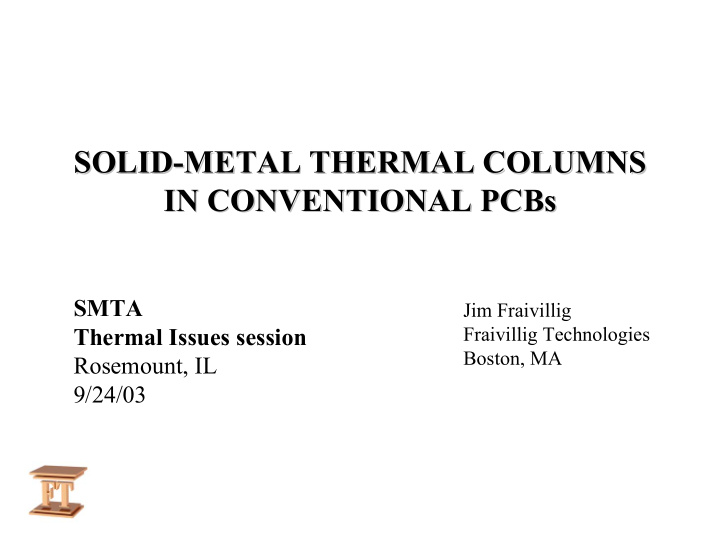



SOLID- -METAL THERMAL COLUMNS METAL THERMAL COLUMNS SOLID IN CONVENTIONAL PCBs IN CONVENTIONAL PCBs SMTA Jim Fraivillig Thermal Issues session Fraivillig Technologies Boston, MA Rosemount, IL 9/24/03
PowerVia technology PowerVia technology Optimal through- -hole thermal transfer hole thermal transfer Optimal through All-polyimide construction SOLID- SOLID -METAL THERMAL COLUMNS METAL THERMAL COLUMNS IN CONVENTIONAL PCBs IN CONVENTIONAL PCBs
PowerVia technology PowerVia technology Optimal through- -hole thermal transfer hole thermal transfer Optimal through SOLID- SOLID -METAL THERMAL COLUMNS METAL THERMAL COLUMNS IN CONVENTIONAL PCBs IN CONVENTIONAL PCBs
PowerVia technology PowerVia technology Optimal through- -hole thermal transfer hole thermal transfer Optimal through PowerVias for D2Paks PowerVias inserted into PCB SOLID- SOLID -METAL THERMAL COLUMNS METAL THERMAL COLUMNS IN CONVENTIONAL PCBs IN CONVENTIONAL PCBs
Comparison with Comparison with conventional thermal via conventional thermal via SOLID- SOLID -METAL THERMAL COLUMNS METAL THERMAL COLUMNS IN CONVENTIONAL PCBs IN CONVENTIONAL PCBs
PowerVia technology advantages PowerVia technology advantages • High thermal transfer Design flexibility: 2X conventional plated-thru hole • Double-sided PCBs • No pressure dependency • ‘Snap-on’ PCB to standard heat sink • All polyimide durability Excellent electrical and physical • Optimize supply of both properties PCB and heat sink • Testing flexibility (thermal mass of PowerVia) SOLID- SOLID -METAL THERMAL COLUMNS METAL THERMAL COLUMNS IN CONVENTIONAL PCBs IN CONVENTIONAL PCBs
SOLID- SOLID -METAL THERMAL COLUMNS METAL THERMAL COLUMNS IN CONVENTIONAL PCBs IN CONVENTIONAL PCBs
PowerVia installation PowerVia installation 1. Insert into pre-routed PCB PowerVias can be: (‘ bottom side ’) • Press-fit 2. Solder on power devices (‘ top side ’) • PS-adhesive attached 3. Mount assembled PCB on heat sink SOLID- SOLID -METAL THERMAL COLUMNS METAL THERMAL COLUMNS IN CONVENTIONAL PCBs IN CONVENTIONAL PCBs
Thermal transfer testing Thermal transfer testing Thermal resistance testing of D2Pak (R j-s ), using PowerVias Anatech pulse tester: • Conventional thermal via D2Pak (plated-thru-hole + insulation pad + attachment hardware) • Cylindrical column PowerVia • Rectangular column PowerVia Thermal vias SOLID- SOLID -METAL THERMAL COLUMNS METAL THERMAL COLUMNS IN CONVENTIONAL PCBs IN CONVENTIONAL PCBs
NOTE: • Thermal resistance is junction-to-sink. • Anatech measurement taken at steady-state. • PCB secured to heat sink on PCB edges only (50-100 psi?). • Thermal via + pad thermal resistance is about 7 o C thru the power device+PCB and 4 o C/W SOLID- SOLID -METAL THERMAL COLUMNS METAL THERMAL COLUMNS thru the insulation pad. IN CONVENTIONAL PCBs IN CONVENTIONAL PCBs
Pressure dependency Pressure dependency Thermal Impedance vs Pressure Conventional thermal vias require insulation pads… … insulations pads require 1 Thermal Impedance (oC-in2/W) high-pressure to optimize 0.9 Insulated pad thermal transfer to the heat 0.8 Phase-change sink. 0.7 Thermal grease 0.6 0.5 Isolated 0.4 PowerVias use non-isolating 0.3 thermal grease or phase-change 0.2 material… 0.1 Non-isolated …. these thermal compounds 0 have little pressure dependency 0 50 100 150 200 (and very high thermal transfer). Pressure (psi) SOLID- SOLID -METAL THERMAL COLUMNS METAL THERMAL COLUMNS IN CONVENTIONAL PCBs IN CONVENTIONAL PCBs
PowerVia feature: PowerVia feature: Excellent thermal management with conventional PCB packaging � Better thermal transfer and lower cost than Kapton+PSA circuits � Much lower cost than IMS circuits � Denser packaging – double-sided PCBs SOLID- SOLID -METAL THERMAL COLUMNS METAL THERMAL COLUMNS IN CONVENTIONAL PCBs IN CONVENTIONAL PCBs
PowerVia design feature: PowerVia design feature: Double- -sided PCB, with flat sided PCB, with flat- -faced faced Double heat sink heat sink SOLID- SOLID -METAL THERMAL COLUMNS METAL THERMAL COLUMNS IN CONVENTIONAL PCBs IN CONVENTIONAL PCBs
PowerVia design feature: PowerVia design feature: Fully- -assembled assembled Fully PCB, ‘snapped’ PCB, ‘snapped’ on to heat sink on to heat sink ( with no pressure dependency with no pressure dependency ) ) (
PowerVia design features: PowerVia design features: Cool power devices on the PCB => Move to SMT from through-hole (with off-the-board cooling) � Unified construction facilitates assembly and testing � More compact designs (higher ‘power density’) � Reduce system cost and SKUs Conventional mounting (heat sink subassembly) SOLID- SOLID -METAL THERMAL COLUMNS METAL THERMAL COLUMNS IN CONVENTIONAL PCBs IN CONVENTIONAL PCBs
PowerVia design feature: PowerVia design feature: Fully- -assembled PCB can be tested assembled PCB can be tested Fully without a heat sink without a heat sink PowerVias have ‘ thermal mass ’ � R-value of 15-30 o C/W (est.) SOLID- SOLID -METAL THERMAL COLUMNS METAL THERMAL COLUMNS IN CONVENTIONAL PCBs IN CONVENTIONAL PCBs
PowerVia design considerations: PowerVia design considerations: � PCB thickness consistency � PCB precision routing for PowerVia ‘hole’ � Volume vs cost SOLID- SOLID -METAL THERMAL COLUMNS METAL THERMAL COLUMNS IN CONVENTIONAL PCBs IN CONVENTIONAL PCBs
PowerVia applications PowerVia applications FORMAT: END USE: • Power supplies HOT COLD Discrete SMT => Heat sink • Automotive control components modules Thermal via => Heat sink (plated-thru hole) • Motion control Daughter PCB => Mother PCB • Motor control SOLID- SOLID -METAL THERMAL COLUMNS METAL THERMAL COLUMNS IN CONVENTIONAL PCBs IN CONVENTIONAL PCBs
Recommend
More recommend